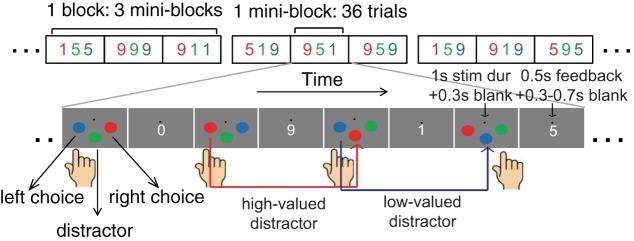Fig. 1.

Behavioral binary-choice task. On each trial, subjects selected 1 of 2 choice stimuli that were on either side of fixation. A task-irrelevant distractor simultaneously appeared below the fixation point. Different reward values (1, 5, or 9) were assigned to different stimulus colors (red, green, and blue) every 36 trials. On each trial, one of the choice stimuli yielded a reward if it was selected (termed a baited stimulus) and the other did not (termed a decoy). If subjects selected the baited target, they received 1, 5, or 9 point(s). If they selected the decoy, they received 0 points. The left stimulus was baited on 50% of the trials, and on the other 50% of trials the right stimulus was baited. The distractor could never be selected and thus could never yield a reward (termed the response-irrelevant distractor). The colors assigned to the left and right choice stimuli and to the distractor were pseudorandomized across trials so that the color of either of the 2 choice stimuli in the current trial could become the color of the distractor in the following trials (red and blue arrows).
